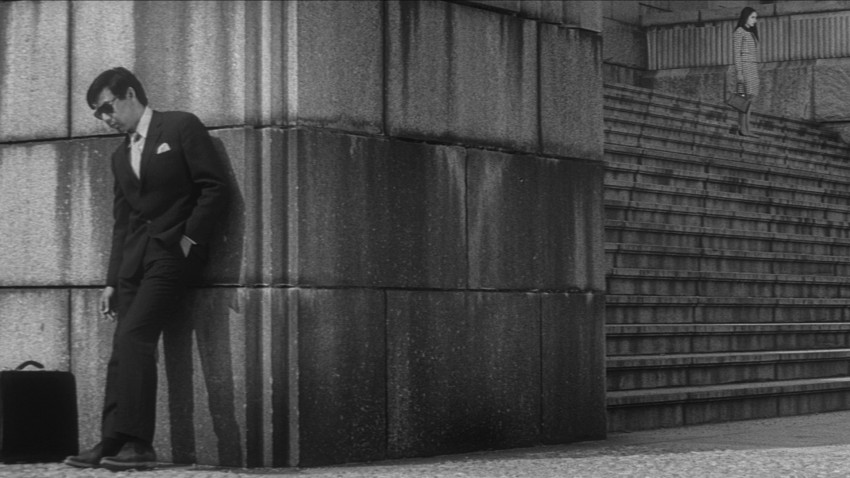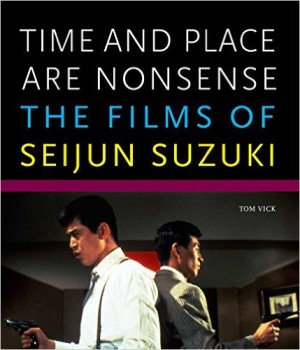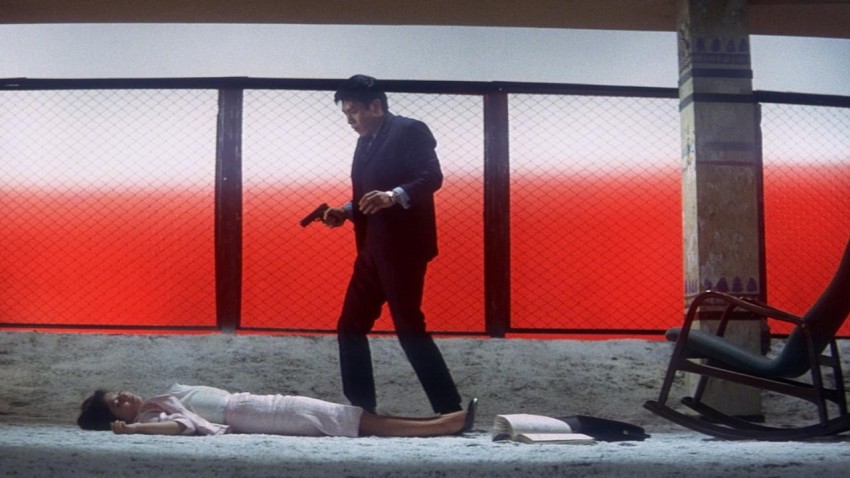Books: The Films of Seijun Suzuki
January 13, 2016 · 0 comments
By Jasper Sharp.
The term manga-esque is so readily applied to Japanese live-action cinema as to have little meaning beyond indicating the country of origin of the work or filmmaker in question. However, in the case of the iconic Seijun Suzuki the label seems apt, although Tom Vick wisely shies away from direct analogies to paint a fuller picture in his new book, Time and Place are Nonsense: The Films of Seijun Suzuki.
The pulp crime and gangster potboilers for which Suzuki is best known, produced for Nikkatsu between 1956 and 1967, are marked by baroque designs with areas of visual interest carefully positioned across the horizontal dimensions of the screen, and a playfully absurd approach to narrative logic that frequently meanders into the realms of the ludicrous. Suzuki’s later filmography also includes one anime feature, Lupin III: Legend of the Gold of Babylon (1985), co-directed with Shigetsugu Yoshida.
We might also note that following the director’s first wholesale introduction to audiences outside of Japan, with the 14-film retrospective ‘Branded to Thrill: The Delirious Cinema of Suzuki Seijun’ that toured across Europe and North America from 1994 onwards, his two best-known titles Tokyo Drifter (1966) and Branded to Kill (1967) were both originally released in the United Kingdom by none other than Manga Entertainment.
 This latter title in particular has become the stuff of legend – a stylish Pop-Art gangster flick so wilfully unorthodox that as soon as he saw what Suzuki had turned in, the incensed Nikkatsu president Kyusaku Hori gave the director his marching orders. As Tom Vick notes early on in Time and Place are Nonsense: “The story makes good copy and went a long way to promote his films in the West, but it has largely pigeon-holed Suzuki as an eccentric B-movie cult director, albeit an exceptionally talented one.”
This latter title in particular has become the stuff of legend – a stylish Pop-Art gangster flick so wilfully unorthodox that as soon as he saw what Suzuki had turned in, the incensed Nikkatsu president Kyusaku Hori gave the director his marching orders. As Tom Vick notes early on in Time and Place are Nonsense: “The story makes good copy and went a long way to promote his films in the West, but it has largely pigeon-holed Suzuki as an eccentric B-movie cult director, albeit an exceptionally talented one.”
Vick’s book is a much-needed attempt at rehabilitating the director into serious film discussion, addressing the formal qualities of his idiosyncratic style in a study that is entertaining, well-written, insightful, and thankfully avoids the impenetrable jargon beloved by academia.
It is not the first monograph to tackle the Suzuki enigma. Shigehiko Hasumi’s collection Suzuki Seijun: The Desert under the Cherry Blossoms was published (in English and Dutch) to accompany a retrospective in the Netherlands in 1991, while a similar catalogue edited by Tony Rayns and Simon Field accompanied the 1994 Branded to Thrill screenings at the ICA. Vick draws upon the contents of these as the starting point for his analysis, as well as a number of other sources that include my own chapter on Suzuki in The Midnight Eye Guide to New Japanese Film. Inevitably there’s a slight air of familiarity to some of these observations, namely one of the main axioms of Vick’s thesis, that of Suzuki’s “repeated confrontations with the limitations of the film medium, the inevitable two-dimensionality of the screen” in which “for him, the screen is not merely a window onto an imaginary world, but a surface to play with” – some ten years ago I myself pointed out “the Suzuki style of treating the cinema screen as merely a two-dimensional image to be filled with as much color and action as possible, and with only the most tenuous basis in reality.” Other examples of the Suzuki method isolated in The Midnight Eye Guide – such as the illogical use of rear projections in Our Blood Won’t Allow it (1964; referred to as The Call of Blood in the new book) and the mystifying initial appearance of a demon mask superimposed over one shot in Gate of Flesh (1964) – are also drawn attention to in Time and Place are Nonsense.
 That said, Vick does cast his net far further than previous studies to take in lesser known works like Satan’s Town (1956), Young Breasts (1958), The Sleeping Beast Within (1960), The Man with the Shotgun (1961), Carmen from Kawachi (1966) and Capone Cries a Lot (1985), with various stand-out aspects of Suzuki’s audacious visual style judiciously illustrated with frame-grabs. Many of these titles were featured in the new ‘Action and Anarchy: The Films of Seijun Suzuki’ retrospective at New York’s the Film Society of the Lincoln Center in November 2015, organised to tie in with this publication. This focus will hopefully go on to bring in new audiences and expand discussions beyond the handful of titles known from his 1960s Nikkatsu period. After all, Suzuki directed almost 50 films in a career from 1956 to the 2005 release of what is sure to be his last offering, Princess Raccoon.
That said, Vick does cast his net far further than previous studies to take in lesser known works like Satan’s Town (1956), Young Breasts (1958), The Sleeping Beast Within (1960), The Man with the Shotgun (1961), Carmen from Kawachi (1966) and Capone Cries a Lot (1985), with various stand-out aspects of Suzuki’s audacious visual style judiciously illustrated with frame-grabs. Many of these titles were featured in the new ‘Action and Anarchy: The Films of Seijun Suzuki’ retrospective at New York’s the Film Society of the Lincoln Center in November 2015, organised to tie in with this publication. This focus will hopefully go on to bring in new audiences and expand discussions beyond the handful of titles known from his 1960s Nikkatsu period. After all, Suzuki directed almost 50 films in a career from 1956 to the 2005 release of what is sure to be his last offering, Princess Raccoon.
Time and Place are Nonsense really makes one want to explore its subject further – the best one can expect from a book of this nature. Suzuki’s visual world is a rich one, even if the director himself often self-deprecatingly joked that his career as a filmmaker was essentially little more than a job and that there is little meaning to his work beyond that which is immediately apparent.
Vick notes “high-energy rambunctiousness was the house style for Nikkatsu Action, and there are many directors who made solid work with the assignments they were given.” The perennial question that remains, however, is just how different were Suzuki’s films from the bulk of the studio’s output throughout the 1960s? This was a time when the company was churning out 60-80 titles a year, very few of which have been seen or discussed in any depth outside of Japan.
There were certainly directors who made more than just “solid” work from assignments handed down to them – Ko Nakahira being but one figure whose output veered wildly across styles and genres and who was also given to his fair share of stylistic experimentation within the studio formula. Moreover, Nakahira’s Danger Paws (1962), starring Jo Shishido (just prior to him becoming the familiar face of Suzuki’s films) also features a scene shot from beneath a glass floor, several years before Suzuki deployed this technique, so often seen as typifying his mould-breaking style.
In a studio system such as that operating at Nikkatsu, no director can truly function in isolation. Suzuki’s collaborator, the designer Takeo Kimura, whose influence became a crucial component of Suzuki’s films from 1963 onwards, also worked with other directors at the studio. How did his input manifest itself in these films, one might ask? Similarly, Suzuki’s experiments in scale and depth as described in the analysis of Underworld Beauty (1957) can also be detected in later Nikkatsu films like Retaliation (1968), made by his former assistant Yasuharu Hasebe. While Vick mentions that Suzuki “frequently used the widescreen Cinemascope format in his Nikkatsu films because its dimensions resembled, for him, the dimensions of the Kabuki stage,” it should be remembered that by 1960 virtually all major productions were shot in this format (Ozu’s late-career work being the notable exception).
While the wider cinematic context occasionally feels lacking, the Kabuki comparison, with its emphasis on a “presentational” rather than a “representational” style, is not misplaced, But nor is it unique to Suzuki; think Kon Ichikawa’s An Actor’s Revenge, for example. It is natural that many of the director’s aesthetic points of references should be traditional ones (as Suzuki indeed has himself stated), and Vick’s attempts to situate the films within the context of indigenous artistic and cultural forms such as ero guro nonsensu and bijinga woodblock prints are certainly valid.
 This is particularly the case when it comes to his dreamlike Taisho Trilogy, comprising Zigeunerweisen (1980), Kagero-za (pictured, 1981), and Yumeji (1991) – probably the least known and least understood of his films. Named after the Taisho era (1912-26) in which Suzuki was born – a brief period of rapid political and social change, artistic experimentation and cultural openness – these more personal works show a completely different and arguably more rounded side to the director than his better-known potboilers for Nikkatsu, and the book benefits immensely from intelligently sketching out the context from which they arise.
This is particularly the case when it comes to his dreamlike Taisho Trilogy, comprising Zigeunerweisen (1980), Kagero-za (pictured, 1981), and Yumeji (1991) – probably the least known and least understood of his films. Named after the Taisho era (1912-26) in which Suzuki was born – a brief period of rapid political and social change, artistic experimentation and cultural openness – these more personal works show a completely different and arguably more rounded side to the director than his better-known potboilers for Nikkatsu, and the book benefits immensely from intelligently sketching out the context from which they arise.
Ultimately, if there is any Japanese director whose films need setting within a proper context, it is Seijun Suzuki. There’s a wonderful case put forward here for Suzuki’s virtues as a filmmaker, his ability to transform even the most rapidly-shot B-movie into a riot of colour, disorienting edits and intriguing spatio-temporal shifts. For a director so often described in terms of being a maverick or an iconoclast, details regarding the contemporary reception to his films and the production circumstances of his post-Nikkatsu years would help enlighten the subject further. Suzuki’s TV films are not included, while even his more leftfield productions such as the Lupin III animation and Capone Cries a Lot are slightly glossed over. And one is still left asking for more background behind the real reasons for Suzuki’s firing from Nikkatsu.
Perhaps these questions, like the feverish dream-logic narratives of films such as Branded to Kill and Zigeunerweisen, and like the motivations of the inscrutable director himself, are mysteries that can’t be and probably don’t even need to be solved. Perhaps…
Jasper Sharp is the author of the Historical Dictionary of Japanese Cinema. Time and Place are Nonsense: The Films of Seijun Suzuki by Tom Vick is published by Freer Gallery of Art and Arthur M. Sackler Gallery.
books, Branded to Kill, Branded to Thrill, film, Japan, live-action, Manga Entertainment, Seijun Suzuki, Tom Vick

Leave a Reply